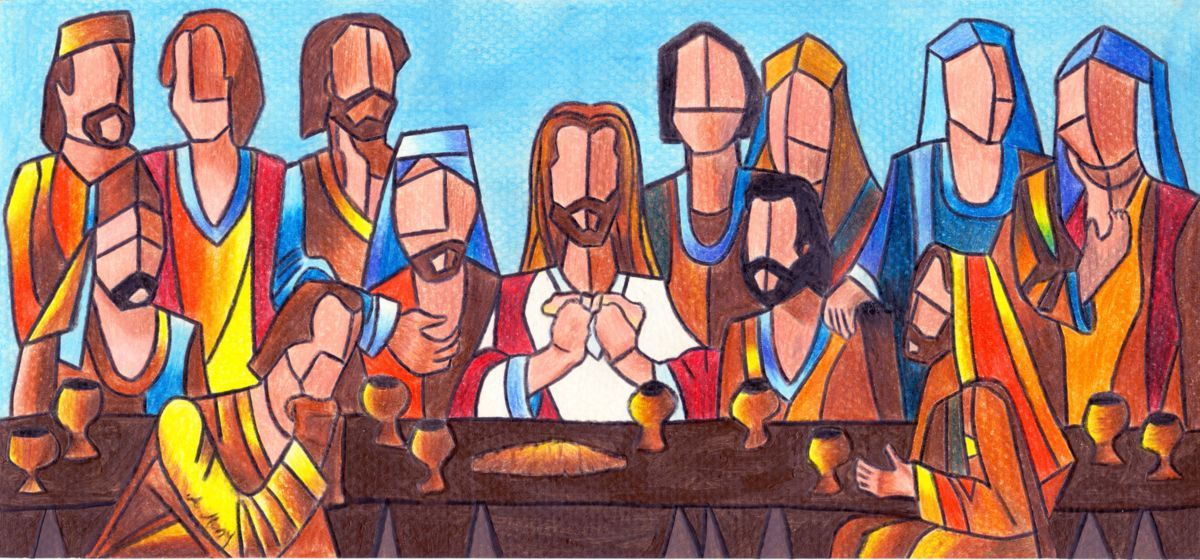image source: https://www.pinterest.com
The Last Supper painting is a masterpiece that has captured the attention of art enthusiasts for centuries. Painted by the renowned artist Leonardo da Vinci, this iconic piece depicts the final meal of Jesus Christ with his disciples before his crucifixion. However, it is not just the religious symbolism that makes this painting so intriguing. One cannot help but wonder, who is in the Last Supper painting? In this article, we will delve into the identities of the figures depicted in this renowned artwork, uncovering the secrets and symbolism behind their placement in the iconic scene. Join us as we explore the intriguing characters who are in the Last Supper painting.
Unveiling the Symbolism in the Last Supper Painting: A Closer Look at the Mysterious Figure
The Last Supper painting by Leonardo da Vinci is one of the most iconic and enigmatic works of art in history. Depicting the final meal shared by Jesus and his disciples before his crucifixion, this masterpiece has captured the curiosity and imagination of people for centuries. While the central figure of Jesus is the most obvious focus of the painting, there is a mysterious figure sitting next to him that has sparked numerous interpretations and debates among art historians. In this essay, we will take a closer look at this figure and unveil the symbolism behind his presence in the painting.
The figure in question is the one sitting to the right of Jesus, with his head leaning towards him. He is often referred to as the “Beloved Disciple” or the “Disciple whom Jesus loved”. This figure has been a subject of much speculation and mystery, as he appears to be different from the other disciples in the painting. His youthful appearance, long hair, and feminine features have led some to believe that he is actually a woman. However, there are several symbolic reasons for his appearance and placement in the painting.
Firstly, the figure’s position next to Jesus is significant as it represents his role as the closest disciple to Jesus. In the Bible, it is said that the disciple whom Jesus loved was the one who sat next to him during the Last Supper. This figure is also depicted as the one who leans towards Jesus, showing his close proximity and intimate connection with him. This symbolism highlights the importance of this disciple in Jesus’ life and teachings.
Another important aspect to consider is the figure’s facial expression. While most of the disciples are shown with a stern or confused expression, this figure has a serene and peaceful countenance. This could represent the inner peace and understanding that he has gained from being close to Jesus and his teachings. It also serves as a contrast to the chaos and turmoil that surrounds the other disciples, who are depicted with varied emotions and reactions to Jesus’ announcement of his impending death.
The figure’s appearance and placement in the painting also hold deeper religious symbolism. His long hair and youthful features are reminiscent of the popular depiction of Jesus in art, which symbolizes his purity and divinity. This could suggest that this disciple has a spiritual connection with Jesus and is seen as a representation of his teachings and message. Furthermore, the figure’s placement at the center of the painting, with his head aligned with Jesus’ heart, could symbolize his spiritual enlightenment and understanding of Jesus’ love and sacrifice.
Lastly, some art historians have also interpreted the figure as a representation of the Church or the Christian community. Just as this disciple is positioned next to Jesus, the Church is seen as being close to Christ and his teachings. The serene expression on the figure’s face could symbolize the peace and comfort that the Church finds in Jesus’ teachings, despite the challenges and struggles it may face.
In conclusion, the mysterious figure in the Last Supper painting holds significant symbolic meaning in the composition. His placement, appearance, and expression all contribute to the overall message and theme of the painting. Whether he is seen as a specific disciple, a representation of the Church, or simply a symbol of spiritual enlightenment, his presence adds depth and complexity to this iconic masterpiece. Through a closer examination of this figure, we can gain a deeper understanding and appreciation for the symbolism and meaning behind the Last Supper painting.In conclusion, the last supper painting is not only a masterpiece of art, but it also holds significant historical and religious significance. The painting, created by Leonardo da Vinci, depicts Jesus Christ and his twelve disciples at the last supper before his crucifixion. The identity of the figures in the painting has been a topic of much debate and speculation, with many theories and interpretations. However, one thing is certain – the last supper painting is a timeless and iconic representation of one of the most pivotal events in Christianity. So, who is in the last supper painting? The answer may never be definitive, but the impact and symbolism of this renowned work of art will continue to captivate audiences for generations to come.
Reference
- Witness The Last Supper Come To Life In THE LIVING LORD’S SUPPER At The Rose Center Theater, https://www.broadwayworld.com/costa-mesa/article/Witness-The-Last-Supper-Come-To-Life-In-THE-LIVING-LORDS-SUPPER-At-The-Rose-Center-Theater-20240226
- Newly discovered Plautilla Nelli painting to be restored, https://www.theflorentine.net/2024/03/06/newly-discovered-nelli-painting-to-be-restored/
- Windows 11 Paint app could get another AI feature, but what it’ll do is a mystery so far, https://www.tweaktown.com/news/96470/windows-11-paint-app-could-get-another-ai-feature-but-what-itll-do-is-mystery-so-far/index.html
- Supper Clubs in New York Are a Vanishing Breed. Café Carlyle Is Keeping the Tradition Alive., https://www.nytimes.com/2024/03/06/t-magazine/cafe-carlyle-cabaret-supper-club-new-york.html
- When is Easter in 2024? Here’s why the holiday moves dates, https://www.msn.com/de-de
- You’ve seen the Mona Lisa before, but never like this, https://www.smh.com.au/culture/art-and-design/you-ve-seen-the-mona-lisa-before-but-never-like-this-20240301-p5f91z.html
- The Eicher family spends time preparing beef for the freezer and for canning, https://www.msn.com/de-de
